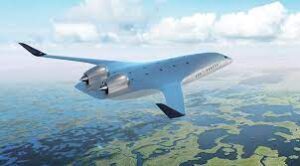I. Introduction: Boeing’s Turbulent Reputation

In the world of aviation, certain companies are deemed iconic, symbolizing greatness and innovation. However, the term “iconic” has taken a different connotation when applied to companies like Xerox, U.S. Steel, and General Electric, often indicating a fall from grace. Boeing, once a titan in the aerospace industry, is now grappling with a tarnished reputation, compounded by recent incidents that raise questions about the company’s commitment to safety and quality.
II. The Glorious Past of Aerospace
Aerospace, particularly on the West Coast, has a rich history steeped in technological innovation. Companies like Hughes Aircraft, Douglas Aircraft, Northrop, North American, Lockheed, and Boeing, based in Seattle, thrived during World War II, producing aircraft for the military. The postwar era saw the industry flourishing, with the Cold War, the space program, and the expansion of commercial aviation providing ample opportunities. However, by the 1970s, aerospace faced challenges from emerging technologies like semiconductors, leading to the decline of some major players in the industry.
A. War-Time Triumphs: Aerospace in its Prime
During World War II, aerospace companies played a pivotal role, manufacturing aircraft for military use. This era marked the industry’s zenith, with companies like Boeing emerging as leaders in aviation technology.
B. Postwar Decline: Aerospace Loses its Luster
The postwar period brought challenges as aerospace began to face competition from emerging technologies, leading to a decline in the prominence of once-dominant companies.
III. Boeing’s Resilience and Success
Amid the shifting tides of the aerospace industry, Boeing demonstrated resilience and continued success. Sustained by an engineering culture committed to designing superior aircraft, the company introduced groundbreaking models that left an indelible mark on aviation history.
A. Engineering Excellence: Boeing’s Golden Age
Boeing’s commitment to engineering excellence was evident in its groundbreaking aircraft, such as the industry-changing 707 in 1958 and the revolutionary 747, the first wide-body aircraft, in 1970.
B. 737: The Workhorse of Aviation
Introduced in 1967, the Boeing 737 became arguably the most successful short-haul airliner in history, showcasing Boeing’s prowess in designing reliable and versatile aircraft.
IV. Corporate Restructurings and Cultural Shifts
While Boeing navigated through its successes, the late 20th century brought about a series of corporate restructurings, each leaving its own imprint on the company. The acquisition of McDonnell Douglas, multiple headquarters moves, and changes in leadership altered the trajectory of Boeing, impacting its corporate culture.
A. Acquisition and Transformation: McDonnell Douglas Era
The acquisition of McDonnell Douglas marked a significant turning point, as leaders from the acquired company assumed top positions at Boeing, reshaping the company’s culture around cost control.
B. Cultural Shift: From Engineering to Profitability
The series of restructurings inadvertently shifted Boeing’s focus from a culture that prized engineering and safety to one seemingly more concerned with delivering profits over perfection.
V. Quality Escapes and Outsourcing Woes
Boeing’s recent incident with the Alaska Airlines Boeing 737 Max 9 door plug, labeled a “quality escape,” sheds light on the company’s increasing reliance on outsourced work. Critics argue that this incident is symptomatic of broader issues tied to Boeing’s outsourcing practices and a failure to maintain rigorous quality control standards.
A. Quality Escape: Alaska Airlines Incident
The alarming incident involving the blown-out door plug on the Alaska Airlines 737 Max 9 highlights a critical “quality escape,” raising concerns about Boeing’s commitment to maintaining rigorous safety standards.
B. Outsourcing Challenges: Spirit AeroSystems
Boeing’s growing reliance on outsourced work, exemplified by Spirit AeroSystems building the problematic fuselage, has raised questions about the company’s ability to manage and maintain quality across its expansive network of suppliers.
VI. Safety as a Cultural Core
Amid Boeing’s pursuit of cost-cutting measures and accelerated production timelines, the company missed a crucial opportunity to embed safety as a cultural core. The prioritization of profitability over safety has raised concerns about the company’s ability to ensure the highest standards in its aircraft manufacturing processes.
A. Missed Opportunity: Safety as a Competitive Advantage
Boeing’s emphasis on cost control and rapid production missed the chance to establish safety as not just a regulatory requirement but as a cultural core and a competitive advantage in the aviation industry.
B. Balancing Act: Safety vs. Profitability
The prevalent notion that safety equals cost has challenged corporations like Boeing to strike a delicate balance between ensuring safety standards and meeting financial expectations, often at the expense of the former.
VII. Consequences of Strategic Decisions
In 2011, Boeing faced a pivotal decision when it greenlit the 737 Max instead of investing in a new short-haul aircraft. While the decision aimed to counter looming competition from the Airbus A320neo, it committed Boeing to a challenging trajectory that would eventually lead to fatal crashes and the grounding of the 737 Max.
A. Fateful Decision: Greenlighting the 737 Max
The decision to proceed with the 737 Max in 2011, driven by competitive pressures, set Boeing on a challenging path marked by rushed development and complex negotiations with regulatory authorities.
B. Managing Certification: FAA and the 737 Max
Boeing’s adept management of the Federal Aviation Administration (FAA) during the 737 Max certification process, intended to save customers time and money, inadvertently contributed to the challenges faced by the redesigned jet.
VIII. Brain Drain and Production Challenges
Boeing’s struggles extended beyond the design and certification phases, with a notable brain drain in late 2022 as experienced engineers left the company, leaving Boeing grappling with significant challenges in addressing safety and production issues.
A. Talent Exodus: Boeing’s Brain Drain
In late 2022, Boeing experienced a significant loss of experienced engineers, contributing to a decline in the company’s capacity to address safety and production challenges effectively.
B. Production Woes: Challenges with the 787 Dreamliner
Even before the recent Alaska Airlines incident, Boeing faced substantial problems with its 787 Dreamliner production in South Carolina, further complicating the company’s efforts to regain its footing in the industry.
IX. The Road Ahead: Boeing’s Strengths and Challenges
Despite its recent setbacks, Boeing remains one of the world’s major airframe makers, boasting strengths such as the ability to integrate complex systems into functional passenger planes. However, the company must confront safety concerns and production challenges to regain its former glory.
A. Strengths Amid Challenges: Boeing’s Unique Capabilities
Boeing’s ability to integrate complex systems into functioning passenger planes remains a distinctive strength, offering the company a foundation on which it can rebuild its reputation.
B. Navigating Challenges: Boeing’s Path to Redemption
As Boeing’s Chief Executive, David Calhoun, promises full transparency during the investigation into the Alaska Airlines incident, the company faces a critical juncture. Navigating through challenges in safety, production, and corporate culture will determine Boeing’s ability to redefine itself and regain its status as a manufacturing icon.
X. Conclusion: Navigating a Course Correction
Boeing, facing intense scrutiny and ongoing investigations, stands at a crossroads. With the global demand for over 45,000 new airliners predicted through 2042, Boeing has a unique opportunity to redefine its legacy. By prioritizing safety, addressing flaws in its corporate culture, and learning from past mistakes, Boeing can chart a course correction towards regaining the trust of customers, stakeholders, and the aviation industry at large. The road to recovery may be challenging, but the demand for passenger jets offers a potential runway for redemption.

Related Topics:
- Market Leadership Endures: Ramesh Damani Advocates Investment in PSUs – Micro2media
- Conquering Financial Uncertainty: Your Guide to Mitigating Risks with a CPA – Micro2media
- A look back at Boeing and Spirit AeroSystems’ turbulent year | Supply Chain Dive
- The History of Aviation Safety | HRD Aero Systems
